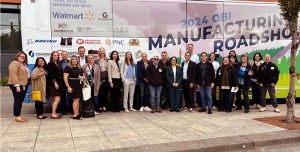As a community-engaged bank, the SF Fed seeks out real-time information on economic conditions by engaging with and learning from businesses, community organizations, and local leaders. These conversations are one of the many inputs into the decisions and monetary policymaking at the Federal Reserve as we pursue our mission.
Here’s a snapshot of a recent outreach in Oregon from Laura Choi, Executive Vice President of Public Engagement.
The Pacific Northwest is a vital region for the nation’s grain industry as it has an extensive network of transportation infrastructure including river ports, railways, and highways that connect inland grain-producing regions to coastal export terminals. As a key gateway for grain exports to Asia and beyond, the Pacific Northwest supports the nation’s production and export of grains like wheat, corn, and soybeans.
Economic conditions in the grain industry impact the livelihoods of farmers and agribusinesses across the country and play an important role in the global food supply. To learn more about the opportunities and challenges facing these businesses, my colleague Ian Galloway, Regional Executive of the SF Fed’s Portland Branch, and I recently visited Columbia Grain International, a global company that sources, processes, and distributes agricultural products like grains and pulses, which are the edible seeds of legumes such as lentils and chickpeas.
As part of the SF Fed’s commitment to listen and learn from the people we serve, this public engagement visit helped us better understand the real-time issues facing the farmers and businesses that make up the grain export industry, and their implications for the broader economy. We learned about current economic conditions and other factors influencing the industry, such as geopolitical conflict, trade policy, and extreme weather. We also had the opportunity to tour the export terminal, which transfers grain from incoming railcars to oceangoing vessels through a network of conveyor belts, grain elevators, and storage silos. During our visit, we learned about the testing procedures used to determine the quality attributes of the grain, as well as the monitoring systems that track the movement of railcars and barges to ensure efficient logistics. It was a fascinating opportunity to get an inside look at this part of the U.S. agricultural supply chain.

In the featured picture, we stood in front of a M/V Phakeboat. The vessel can hold nearly 1.6 million bushels of wheat, which can produce more than 66 million pounds of pasta. Since the average American consumes 20 -pounds of pasta per year, that’s enough to feed more than 3 million people 20 pounds of pasta for an entire year.
These opportunities to meet face-to-face with businesses in the 12th District are important to our understanding of economic conditions on the ground. We appreciate the insights and expertise that our Regional Community and Economic Perspectives network shares with us.
The views expressed here do not necessarily reflect the views of the management of the Federal Reserve Bank of San Francisco or of the Board of Governors of the Federal Reserve System.




